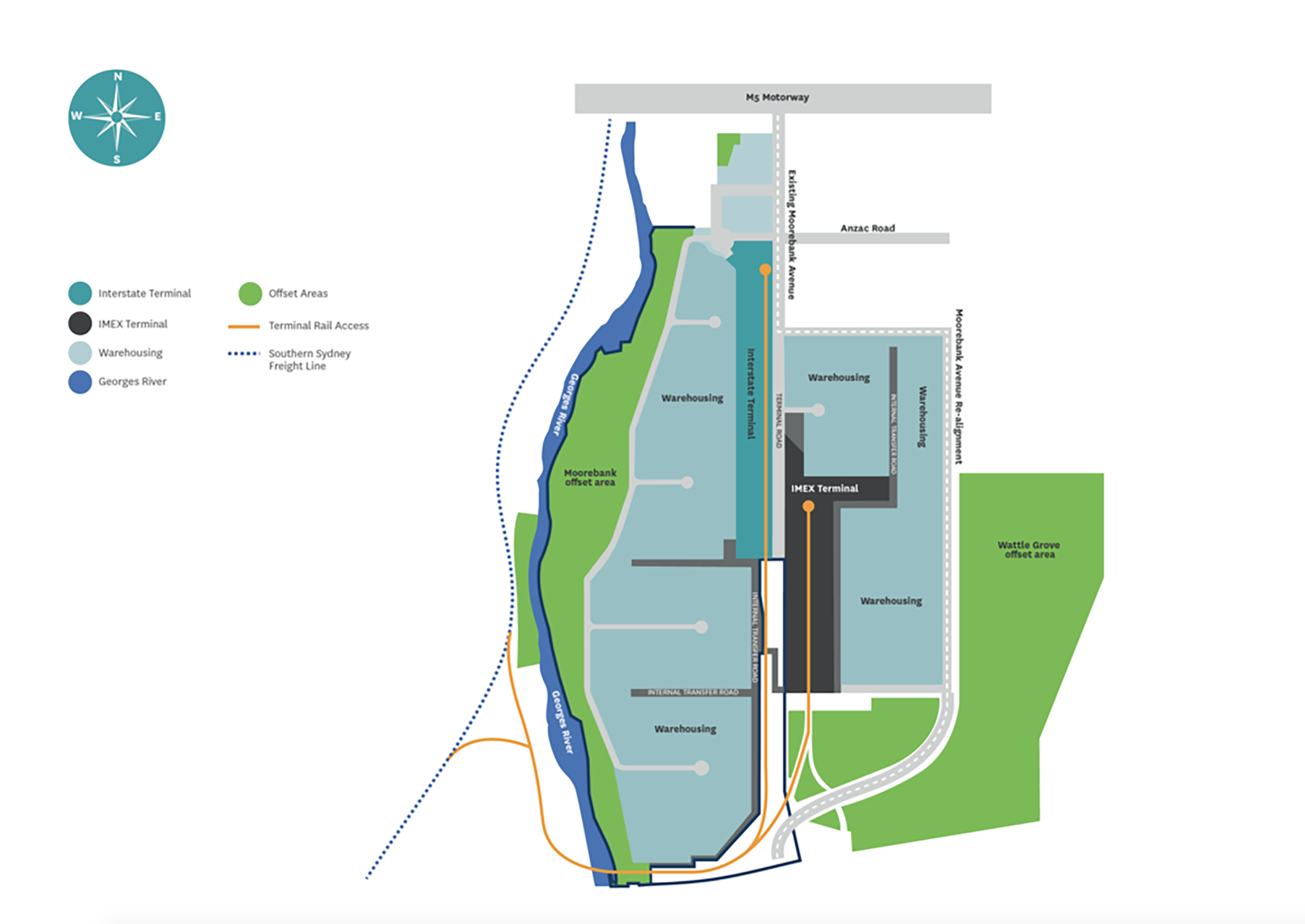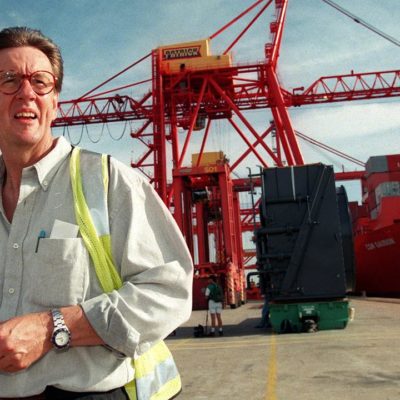Chris Corrigan, golden boy of the Liberal Party, villain of Labor, has won a $1.7bn windfall for his company Qube in a Sydney land deal. Luke Stacey investigates the business and politics of the Corrigan deal as Melbourne prepares to announce its own inland port. Taxpayers beware.
How good is a large parcel of land in Sydney – care of the Federal Government – a contract with no other tenderers, then a $1.7 billion sale?
So far so good for Liberal Party hero Chris Corrigan and his logistics group Qube. The deal is not quite closed yet, though Qube is destined to make a cool $1.7 billion from the Federal Government’s Moorebank Intermodal Freight Terminal in Sydney’s West thanks to the Coalition. As one observer of the Moorebank negotiations remarked, “Qube: 100, Government: zero”.
Corrigan (now retired from Qube) is a hero of the Liberal Party for the same reason he is a villain of the Labor Party, having crushed the unions on the waterfront in 1998.
His hero status in the Liberals however proved a poison chalice for Qube once Labor reached office in 2007 and has thwarted the development of the inland port for years since. This is a story about policy being vanquished by politics. The result at Moorebank is an epic waste of public money and a nightmare for motorists, residents, the NSW freight industry and, even at times, the $1.7 billion man himself.
The tortuous negotiations over the Moorebank deal also serve as a warning call for Victorians, as Qube is now bidding to operate Melbourne’s new inland port. Victoria will receive $3 billion in infrastructure spending as part of the 2021 Federal Budget, two-thirds of which is earmarked for the Melbourne Intermodal Terminal; a project intended to facilitate Australia’s Inland Rail. The development proposal has been shortlisted to two sites: Beveridge, 40 kilometres north of Melbourne, and Truganina in the city’s inner-west.
Contacted for this story, the Federal Government declined to say whether there were any particular infrastructure groups already attached to the project. However, Qube announced back in 2019 that it had “entered into an exclusive call option to acquire 1,100 hectares of land at Beveridge” a year earlier. This suggests there may have been some sort of deal struck. An exclusive call option is an option to buy – exclusively – though there are still two sites in Melbourne apparently under consideration.
BossKeeper: ports giant Qube bullies its way into Jobkeeper and plush bonuses
Destined to fail
In Sydney, the terms of the deal with Qube at Moorebank require the buyer, property developer Logos, to take over “funding and delivery of the [overall] development for the project, including the funding of a warehouse distribution facility [for Woolworths]”.
Qube will retain 100% interest in the import/export (IMEX) Terminal operations on the site. The key issue about this sale, though, is that a private company has turned a profit from land which has cost the public roughly $1.8 billion in road developments, shifting a military base and paying for rail access.
The impact on the residents of the East Liverpool region is significant; air quality, noise levels and traffic congestion.
President of the East Liverpool Progress Association Michael Byrne has continuously lobbied the government for better public policy surrounding the project. He told Michael West Media that Moorebank should never have been approved and is in breach of the ‘Evaluation on Site Suitability and Public Interest’ clause in the NSW EPA Act.
“[The Terminal] is a multi-billion dollar development which causes more problems than it solves. It is a choke point situated on the edge of its distribution channels rather than at the centre.”
According to Qube, the Terminal will “create around $9 billion in economic benefits over 30 years”. Byrne says that “based on this supposed national benefit it is difficult not to support the project … But the claimed benefits are false.”
The site is boxed in by the Georges River to the west and a large stretch of military land to the south. Freight travelling by road for the Terminal must use the M5 Georges River Bridge and Liverpool Bridge, both of which carry almost as much traffic as the Sydney Harbour Bridge and Tunnel combined.

Moorebank Terminal Site
Congestion, accident hotspot
In a 2019 NRMA survey of more than 23,000 NSW drivers rating the state’s most congested roads, the M5 at Moorebank took top spot. Similarly, insurance company AAMI used its claims data to determine the Hume Highway at Liverpool the worst accident hotspot in Sydney between 2014 and 2019.
Despite the challenges of both environment and planning, the Moorebank site became a key driver in the Howard Government’s 2004 ‘Building Our National Transport Future’ election policy. Yet it was not the government that first earmarked the land (occupied by the military) as a potential freight hub. Rather, it was their golden boy Chris Corrigan, who allegedly discovered its potential from his helicopter in the late 90s.
Incapable of saying no to the logistics magnate, the Liberals embraced Corrigan’s vision of the site’s suitability given its access to key motorways and proximity to the Southern Sydney Freight Line (“The Railway”). The primary argument for the proposal was that the Terminal would exacerbate congestion from Port Botany, yet a report from engineering consultants Aurecon noted this was merely an expensive “redistribution of heavy vehicle traffic” from Botany to Moorebank.
An increase in idle traffic has a direct impact on the already compromised air quality of the East Liverpool Region which often exceeds daily emissions as set by the National Environment Protection Measure. However, according to the project’s Environmental Impact Assessment, “it has been assumed that the same level of emissions would occur across the roads modelled”.
Keep your enemies closer
The project has not always been a single development for Qube, however, and the last people Corrigan would have wanted to contend with moved in next door; the Labor Party. The Terminal was originally divided into two parts:
- Moorebank Precinct East (“Moorebank East”): This is the Qube/Corrigan site that was completed as an IMEX Terminal in November 2019.
- Moorebank Precinct West (“Moorebank West”): established by Labor in 2008 under a government business enterprise Moorebank Intermodal Company. The land was originally occupied by the School of Military Engineering and sat directly adjacent to Moorebank East, separated only by Moorebank Ave. Moorebank West was intended as an Interstate Terminal, yet to this day sits as a 220 hectare dustbowl which has cost $1.8 billion in taxpayer money, the bulk of it used to relocate the military school.
In 2008, the Rudd Government used its advisory board Infrastructure Australia (IA) to facilitate the development of Moorebank West. To expedite the process, IA placed the project on the Final Priority List – which according to a 2010 report from the Australian National Audit Office (ANAO) was done without providing the required cost-benefit analysis.
Labor used a $300 million budget drawn down from its ‘Nation Building Program’ to fund Moorebank West and conducted a $70 million feasibility study for the project.
In September 2010, the Department of Finance and Deregulation issued a ‘Current Issue Brief’ for the project which found:
“The cost of relocating Defence from the Moorebank site and development of an [Interstate Terminal] … would impact on the underlying [budget], as funds for the expected full cost have not been set aside in the Nation Building Program.”
They weren’t wrong. To move the military school just 4 kilometres down the road to Holsworthy cost taxpayers $870 million. The relocation became the largest ever development project for the Department of Defence, yet there has been no real benefit for Defence. Just a move.
Freight Infrastructure Advisory Board
Although supportive of the Moorebank Terminal, Labor’s interests in the project were quite different from the Liberals, who have long admired and appeased Chris Corrigan.
As Byrne says,
“Corrigan was outright despised by the Labor Movement since his trade union busting of 1998.” With Moorebank, “Labor took to ‘playing the man’ rather than taking the project on its merit as a matter of public policy.”

Chris Corrigan during the waterfront dispute in 1998
A year earlier, Knowles blocked Corrgian from expanding a similar road-rail freight terminal at Ingleburn that would allegedly reduce fuel use by 1.7 megalitres and emissions by 4550 tonnes. Yet councillors, under instruction from Knowles, pushed back on the proposal, citing noise and traffic concerns. However, the NSW Land & Environment Court later ruled in Corrigan’s favour.
Despite Knowles’ opposition towards Ingleburn, the Freight Board issued a report in 2005 lobbying for a terminal at Moorebank for reasons echoed by Corrigan and the LNP, seemingly ignoring its similar environmental and logistical shortcomings that would manifest on a larger scale.
Corrigan’s interest in Moorebank was known at this time. Why then, would Labor want to potentially set up shop directly next door and in competition with their enemy? Especially given the Freight Board “identified a large private land holding at Eastern Creek as the best of the available sites to meet the strategic needs of [Western Sydney]”.
Short-lived advantage
Simply put, Labor’s presence at Moorebank West gave them territorial advantage as the site sits between Qube (Moorebank East) and the Railway, blocking Corrigan’s access to freight via rail. Access required landowners’ consent for Qube to build a rail link to Moorebank East, and similar to the Ingleburn saga in 2004, Labor denied Corrigan at every opportunity.
In March 2012, then Liberal Premier for NSW Barry O’Farrell wrote to Prime Minister Julia Gillard informing her that Qube “have written to the NSW Government advising that they intend to build the connecting rail line and the freight facilities … at no cost to either of our governments”. However, nothing changed, until the Liberals returned to power the following year.
And with the change of office, Corrigan was back in the driver’s seat, securing a deal with the Government to expand Qube’s interests into Moorebank West.
However, a 2017-18 report from the ANAO determined “shortcomings in the management of probity” on behalf of the Liberal Government, concluding that the deal “was not sufficiently competitive” as the open tender was suspended “to enter into direct negotiations with [Qube]” despite several other expressions of interest.
“Between the commencement of direct negotiations and the final contracted outcome, [the Liberals] agreed to arrangements that have increased the Australian Government’s financial contributions and contingent liabilities.”
This is best represented in the site’s Land Trust; a 99-year lease which sees the Government receive around two-thirds of the rent for private interests to operate on the Terminal. The issue being, however, is “the value of land rent revenue streams [diminished] progressively throughout negotiations … to a contracted position well below market rates”.
Public shortchanged?
All this means the taxpayer is receiving an even smaller return on the costs it has laid out to establish Moorebank West under both governments.
And there was more bad news to come. The final contracted outcome for Qube “involved the Australian Government funding the entirety of the [rail access link]”, costing $380 million; a fee Qube was willing to pay in 2012. What’s more, a person involved in the negotiations told Michael West Media that the cost for government to realign Moorebank Ave had “doubled since 2015”.
As stated by the ANAO, the various public expenses stand at odds with the initial proposal that “no government subsidies would be sought to fund development of [Moorebank West]”.
The biggest win for Qube, though, is that the open access regime (meaning any logistics operator has access to the Terminal) applies only to the site’s various freight terminals “but not the warehousing component of the Moorebank precinct”.
It is this friendly favour from the Liberal Government (which was not part of the original negotiations) that has allowed Qube to privatise the Terminal’s warehousing to the tune of $1.7 billion.
According to the contract observer: “This is the most complicated property development I’ve ever seen”, and its issues throughout negotiations best encapsulated by the 18-month gap between contract close in 2015 to financial close in 2017.
“Simply put, this contract is Qube: 100, Government: zero.”
Luke Stacey was a contributing researcher and editor for the Secret Rich List and Revolving Doors series on Michael West Media. Luke studied journalism at University of Technology, Sydney, has worked in the film industry and studied screenwriting at the New York Film Academy in New York.

